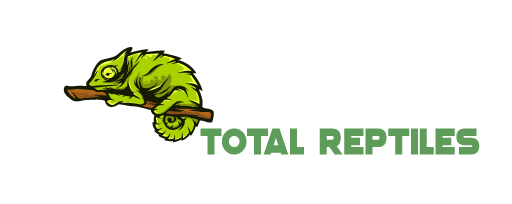Have you been noticing a lethargic change in your beardie? Does it look exhausted and seems inattentive to any appealing meal?
You are most probably experiencing the biological phenomenon called brumation. A new owner must understand the bearded dragon brumation occurrence to help it undergo through the stage peacefully.
It is when the dragon is at a vulnerable stage due to the inability to regulate its own body heat. Hence, you have to make sure the vivarium territory it resides in is similar to the native habitat.
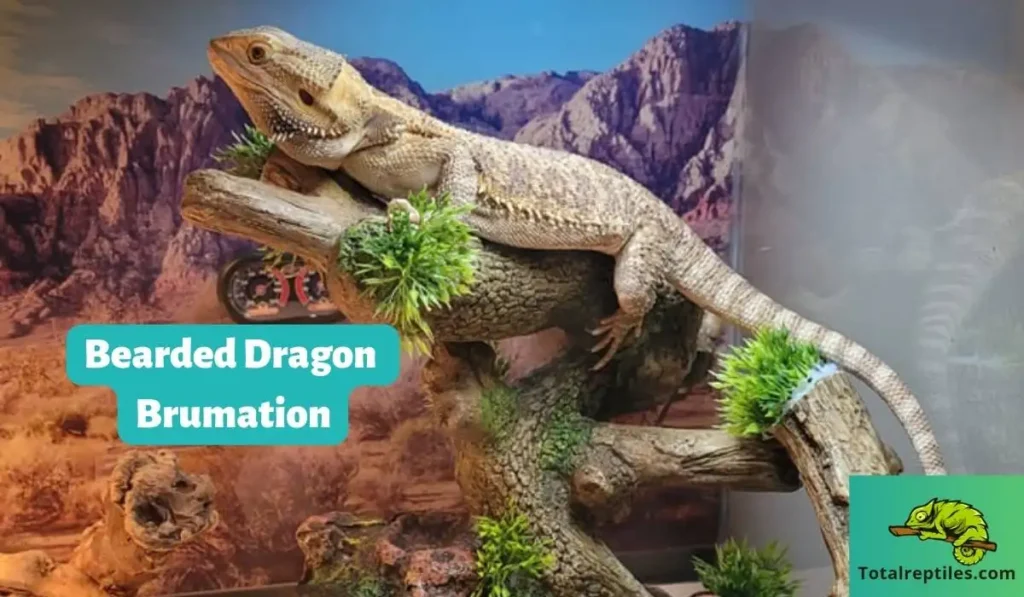
Let’s go into the details step by step!
What Is Bearded Dragon Brumation?
A docile pet that becomes more inactive can scare any first-time beardie owner. This dormancy or brumation is natural for many reptiles in the wild.
Desert winters in Central Australia are harsh for a bearded dragon. So, it brumates to protect its metabolism and cellular function from prolonged adverse cold conditions by conserving energy.
But it can be difficult to discern whether your reptile is alive or is in brumation. Read the section below to see the difference.
· Bearded Dragon Brumation or Dead
Not all bearded dragons behave the same way. For instance, perhaps yours slept throughout the period in the winter months, but the other occasionally woke up and opened its eyes.
This is known as partial brumation, where some Pogona Vitticeps brumate with eyes open but still under stasis for energy conservation.
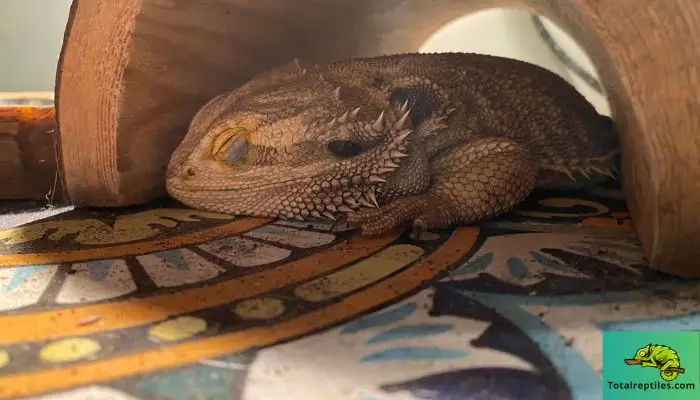
The point is you should not worry about either behavior if the beardie is in a healthy state. Concerns regarding the creature are completely normal, especially when you are unsure whether it is in brumation or dead.
You can simply check in on its stable breathing rhythm from time to time.
· Differences Between Brumation and Hibernation
You have likely heard of hibernation and how it works, but brumation also refers to something similar. Take a close look at this comparison table to understand the distinctions.
| Hibernation | Brumation |
| Hibernating animals are endothermic or warm-blooded, e.g., bears. | Brumating animals are ectothermic or cold-blooded, e.g., bearded dragons. |
| The dormancy period of hibernation is longer. | The dormancy period of brumation is short or sporadic. |
| Hibernating animals usually eat large amounts of food prior to hibernation but none during. | Brumating animals decreases food intake before the process. |
| It is common for them to lose 15% to 30% of their total body weight during this state. | They do not lose much of total body weight during brumation. |
| In hibernation, animals stay dormant without drinking or eating. | In brumation, the animals wake up periodically to sustain themselves for survival. |
· How Often Does Bearded Dragon Brumation Occur?
Every bearded dragon has different but specific brumation patterns that are often difficult for humans to predict. While in the wild, the dragons brumate once a year; it can vary for domesticated ones.
Your beardie may go to brumation during –
- Only once in a lifetime.
- Every few years or every other year (the pattern may be predictable or unpredictable).
- Once a year (every year) according to Australia’s cold/winter season.
- Once a year (every year) according to your regional cold/winter season.
All of the above-mentioned possibilities are normal for the species.
Do Bearded Dragons Hibernate?
Once you read the comparison table given earlier, you will know that hibernation is associated with warm-blooded animals only.
While it is loosely alike, brumation and hibernation are not the same. To get the picture clear, keep in mind that some mammals go through hibernation, whereas specific reptiles or cold-blooded animals experience brumation.
However, both dormant processes transpire during cold seasons or when food is noticeably scarce. On the other hand, bearded dragons go to brumation the moment they sense a drop in the temperature.
Meaning this phenomenon can occur with your cold-blooded animal any time of the year depending on the temperature. This is why the case of bearded dragons is called brumation, not hibernation.
How Long Does Brumation Last for Bearded Dragons?
It all depends on the biological clock the beardie follows. Remember that brumation is an essential survival tactic for them in the wilderness.
Nevertheless, it is an unnecessary behavior for captive dragons, so the pattern and period become varied individually.
Therefore, bearded dragons in their native landscape go to brumation for:
- Three to four months around the same time.
Whereas domesticated bearded dragons go to brumation for:
- A few weeks
- Less than a month
- Over a month
- For three to four months
- Up to eight or nine months
You should consult a vet if your pogona brumates over four months just to be on the safe side.
Do All Bearded Dragons Brumate?
Suppose you have gathered all the information you needed to prepare for the brumation process. Yet, there is no sign of such a dormant act in your beardie despite the cold season overhead.
At this point, you should know that not all bearded dragons enter brumation! Since the brumation time relies on seasonal cues, captive bearded dragons may follow a physiological pattern different from the external factors in your region.
You can, however, change the timing to match the current weather conditions by increasing the basking temperature and duration as it gets closer to brumation. But we strongly do not recommend it.
Reptiles have evolved to respond to natural environmental cues, and attempting to artificially manipulate their basking temperature and duration can have negative consequences for their health.
It’s best to allow them to follow their natural instincts and adjust to the changing weather patterns on their own.
Bearded Dragon Brumation Signs
This section should be your key focus as a new beardie owner. Bearded dragons become incredibly uninterested during this period. Here are the noticeable symptoms to watch out for:
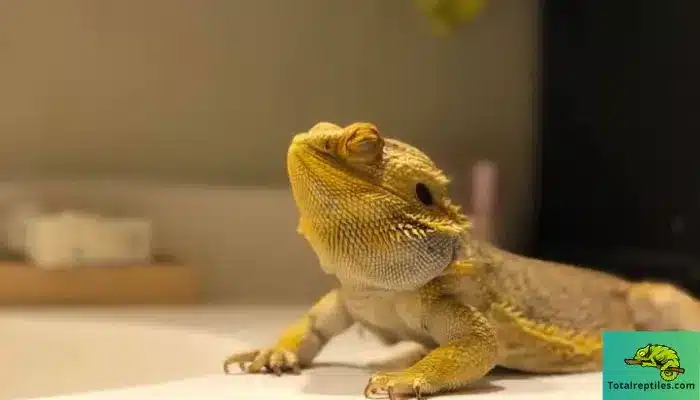
1. Body Temperature Drops
Dragons love basking for prolonged hours, but it begins to spend less and less time in that spot when it is time for brumation. You will see it slowly retreating to the ‘cool zone’ of the vivarium.
As a result, the body temperature decreases as it ignores spending more time basking.
2. Reduced Activity
Pogona vitticeps are perceptibly docile creatures, which is amplified significantly when brumation season is ahead. It will show zero interest in you or other people.
There will even be times when it will completely avoid being handled. Moreover, it will have infrequent bowel movements.
3. Decrease in Appetite
The biggest sign is the lack of appetite or total refusal of any food intake. It is best to notify the vet regardless of the season, as it can also signify other illnesses or parasites.
Just make a brief calculation in your mind to see whether the symptom appears during Australian winter (around June in the U.S.). It means the dragon follows the contrasting pattern, nothing more.
Eating less or not eating at all before brumation is totally normal, though it might scare some owners. Do not force-feed the dragon at this period; it can disrupt its natural instincts and even cause fatal distress.
4. Increased Lethargy
You will also notice that your beardie dragon spends more time feeling tired. It begins to seek darker places to hide or burrow constantly.
This gradual activity indicates a safe nesting spot for the upcoming brumation period, which may last weeks or months. The overall lethargic behavior influences the dragon to increase sleeping hours bit by bit.
5. Appearance Changes
In general, bearded dragons typically turn darker colors when the temperature in the enclosure drops, even by a degree. So, ascertain that the inhabited tank maintains the required temperature before considering it a sign of brumation.
Another point to note is that the color change occurs during the process, not before. Some dragons can turn dark to blacker when the winter months – according to the biological clock – are in full swing.
Preparing for Bearded Dragon Brumation
Most bearded dragons are hard-wired to the Central Australian ecology. So, it is better to prepare yourself in advance to ensure a safe and healthy environment for the reptile.
How do you go about it after noticing the signs and your vet corresponds mutually?
· Temperature and Lighting Requirements During Brumation
The first task is to check the lighting and heating, as these are crucial for changes in the climate.
In the wild, bearded dragons brumate when the temperature in Central Australia goes below 75˚F-80˚F during the day for 8 to 10 hours. The temperature drops further at night, 60˚F-70˚F, which may prompt darker skin pigmentation.
When in captivity, ensure that the enclosure offers similar winter conditions for a smooth brumation experience. For example, opt for a daytime temperature of around 68˚F and a nighttime temperature of around 60˚F.
You should also reduce the daylight duration to simulate shorter days in winter. Switching off the lights a couple of hours earlier than the current schedule will help.
Then continue to decrease the lighting and heating over the coming days before turning off the UV and basking light completely to attain an ideal winter environment.
· Tips for Ensuring a Safe and Healthy Brumation Period
Other helpful suggestions include:
- First, have a fecal test for beardie. Having parasites and brumation presents very similar symptoms.
- Then, try to offer a light belly massage for a bowel movement before full brumation. Otherwise, the food can rot in the stomach.
- Include artificial caves, planters, or various natural décors to mimic safe burrowing/hiding spots.
- Never force feed your beardie forcefully before or during brumation.
- You can offer water to drink but do not force it on the lizard; it may have adverse consequences.
Caring for a Bearded Dragon During Brumation
Although no strict rules are set on caring for captive bearded dragons while asleep, i.e., brumating, try to make things as comfortable as possible. Let us begin with its nourishment routine.
· Hydration and Nutrition During Brumation
Bear in mind that beardies lose their appetite before brumation, which transforms into a complete no-food stage during the process. Some dragons may eat tiny amounts when in a partial-brumation state. However, it is a rare sight.
In any case, beginners often wonder about the bowel movement rate at this stage. Thankfully, they hardly poop during brumation, meaning you do not need to maintain the tank repeatedly.
On the contrary, dragons will wake briefly to drink water. This keeps them hydrated throughout the season. So let them have access to fresh water in a bowl.
· How to Safely End Brumation?
Mainly, leave your beardie alone for as long as possible. Brumation is confusing for human owners, so trust your dragon to come out of it naturally.
Ending brumation means intervening in their natural event physically. It can disturb the dragon’s biological clock and force it to slumber more extensively.
The best way to end brumation is by preventing it from happening in the first place. And you should do it only if your pet has insufficient body mass, is sick, or is a juvenile (under 9 months).
Simply avoid exposing it to winter-like conditions in its current habitat. Increase basking temperature above 105˚F as it gets closer to brumation. Lengthen the daytime up to 14 hours as well.
· What to Expect After Brumation?
Note down the behaviors your beardie exhibits during brumation for future reference and your vet. Now, what do you do once it wakes up?
Your dragon will wake up when the brumation is over. Do not be alarmed when you notice it is staring back at you wide-eyed or provoke it much as it starts to crawl around in search of food.
After affirming that the brumation period is over, here is what you can do:
- Set the lighting and heating back to normal in the course of a few days.
- Offer food gradually and in small portions. Include easy-to-digest items and greens at first to help return the full appetite.
- Provide fresh water at all times so the dragon stays hydrated even after being out of deep sleep.
Why Do Bearded Dragons Brumate?
It is time to acknowledge the reasons and the factors that lead to brumation in cold-blooded reptiles.
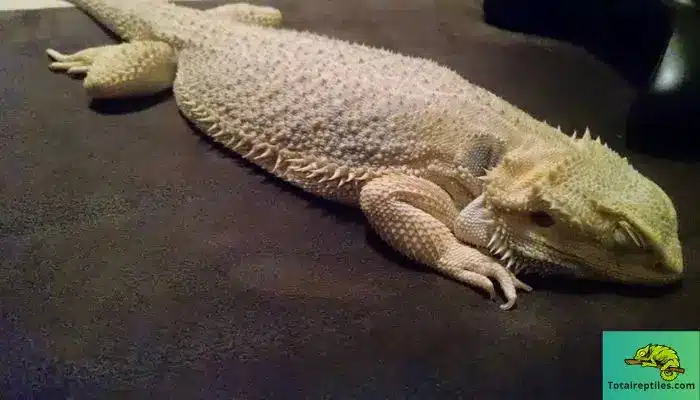
1. Natural Physiological Process
Being ectothermic or cold-blooded, bearded dragons have no control over the temperature regulation in their body. If they did not go through this process in the wild, most would have died and even become extinct species.
Luckily, their natural instinct kicks in when the weather changes and allows them to survive tactically.
2. The Role of Environmental Factors
The geographical origin plays a crucial role in stimulating the brumation process in a beardie.
In the wild, dragons will start looking for holes, caves, crevices, etc., for burrowing and hiding to enter safe brumation. This is because their physiological clock senses the temperature drop in the air.
It can also detect food scarcity in the region that also associate with the drastic heat drop. In captivity, dragons do not need brumation as the owner provides everything. But it can still distinguish seasons despite being in a tank.
Another external factor includes improper maintenance of the enclosure (low temperature, inadequate food portions, etc.). You should check the lighting and temperature to dictate precise husbandry.
3. Benefits of Brumation for Bearded Dragons
Cold winter months mean less chance of proper basking and food sources. So, the beardies seek safe refuge in warmer places to slow down their metabolism. It keeps their body mass at healthy levels by preventing stored energy use up.
When Do Bearded Dragons Brumate?
In other words, when should you expect brumating to take place during captivity, and at what age?
1. What Age Do Bearded Dragons Brumate
Bearded dragons enter brumation when they reach sexual maturity. So far, it has expedited outcomes based on living conditions and maximized nutrition.
For instance, a study shows adulthood or sexual maturity attainment in Pogona vitticeps at 18-24 months of age.
Each adult individual had separate enclosures to avoid territorial discontent. Furthermore, the living conditions were set to a specific lighting and temperature setup with a scheduled day/night cycle.
In short, beardies will brumate a year or two after reaching maturity if housed in the right habitat. However, brumation does not happen in juveniles under 9 months. If it does, we suggest visiting a licensed vet.
2. Seasonal Patterns and Their Effect on Brumation
By now, you have gathered that brumation is linked with cold seasons. You also know that bearded dragons are native to Central Australia, where seasonal patterns differ from the rest of the world.
So, this may help you remember the details better:
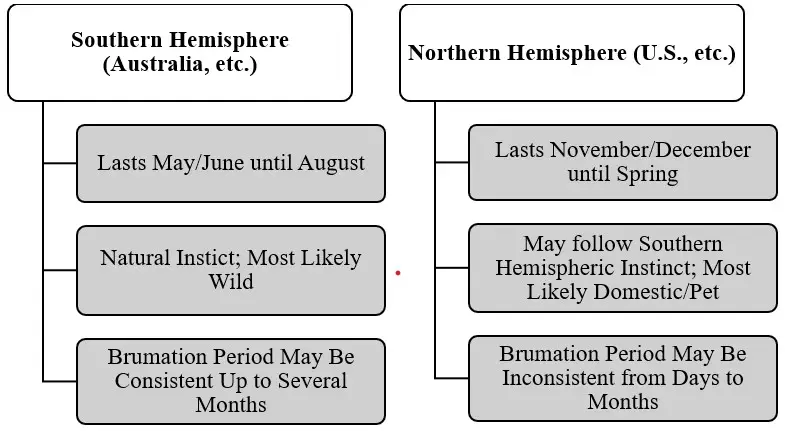
3. Bearded Dragon Brumation in Summer
Once you understand the chart above, you will notice that most bearded dragon owners in the northern hemisphere may encounter dormancy in early summer instead of in the Nov/Dec.
So, due to the engraved biological clock, the instincts kick in regardless of their current location. This behavior is highly visible in captive or domesticated beardies.
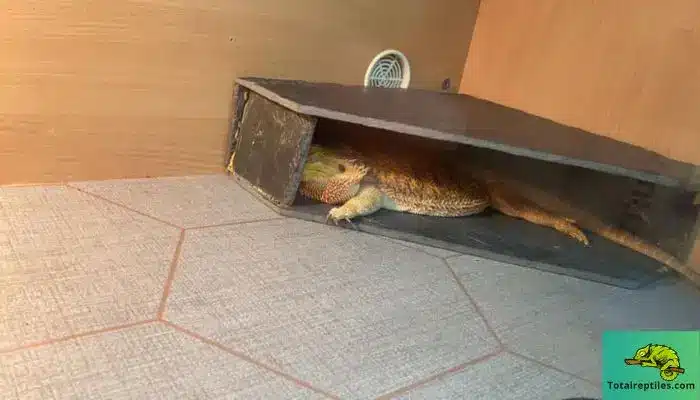
You should still visit your vet to make sure no other sickness is causing the symptoms to appear. Although uncommon, its present habitat or vivarium condition can influence the periodical shift for brumation.
Do Bearded Dragons Eat During Brumation?
The key fact throughout this guide is that a bearded dragon will not eat anything when in a brumation state.
It will wake up for a short while only to hydrate itself by drinking water intermittently. Food intake or defecation is not part of the brumation, so you can rest assured of this unique manner.
On a different occasion, your beardie may want to eat, though most will refuse the offered food. Do not force-feed the reptile when it is out for water between phases.
Frequently Asked Questions
a. What month do bearded dragons brumate?
Dragons brumate around 18-24 months of age. However, you can fast forward the growth spurt via additional nutritious intakes.
b. Do bearded dragons hibernate in captivity?
Bearded dragons brumate instead of hibernation even in captivity, even though it is no longer essential. They simply follow their physiological drive.
c. Can I hold my bearded dragon during brumation?
We strongly recommend against it as the beardie will be in a natural state of deep sleep. Your movements may disrupt its brumation pattern and force it to doze longer.
d. How long can a bearded dragon go without eating in brumation?
Reportedly, it can go more than a month without eating. They drink water instead to stay hydrated.
Conclusion
You may feel overwhelmed at the moment, but bearded dragon brumation occurrence is not rocket science. Once you go through the tips and caring instructions, that is all!
Just be sure not to interrupt its deep slumber, no matter how curious you feel. Pogona vitticeps or the beardies prefer to be left alone. Give them space, and they will love the provided habitat just like back home.
